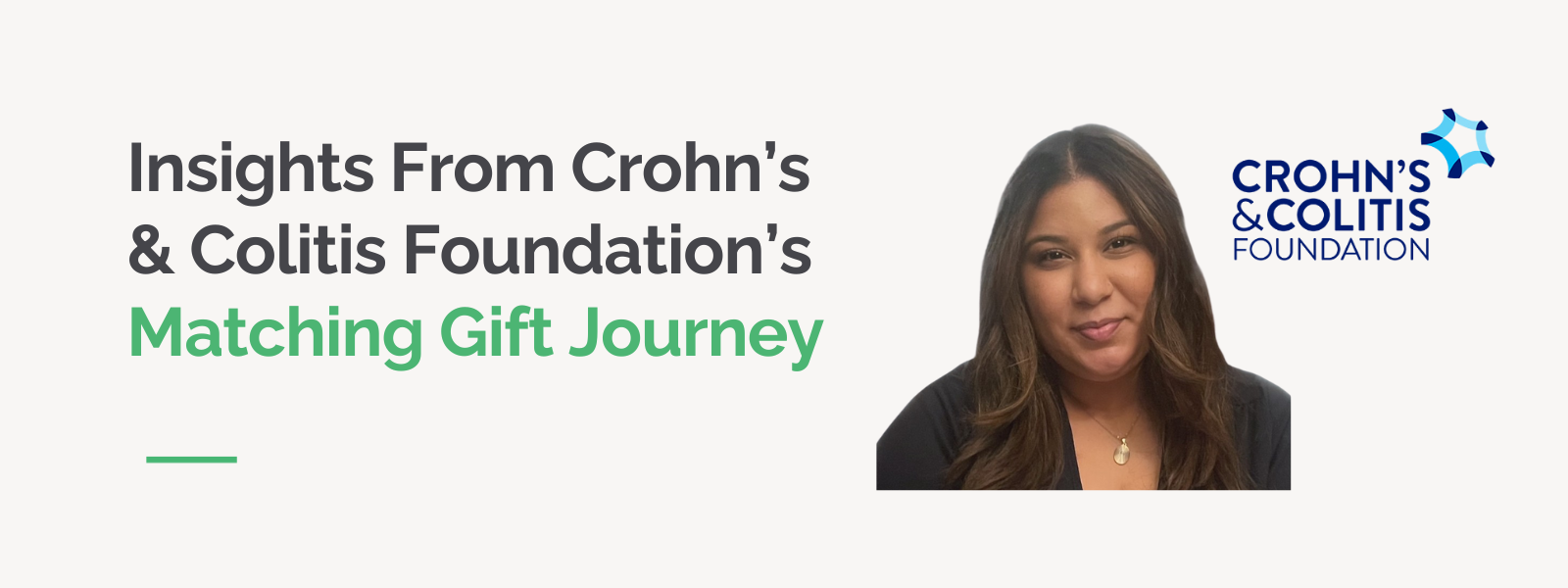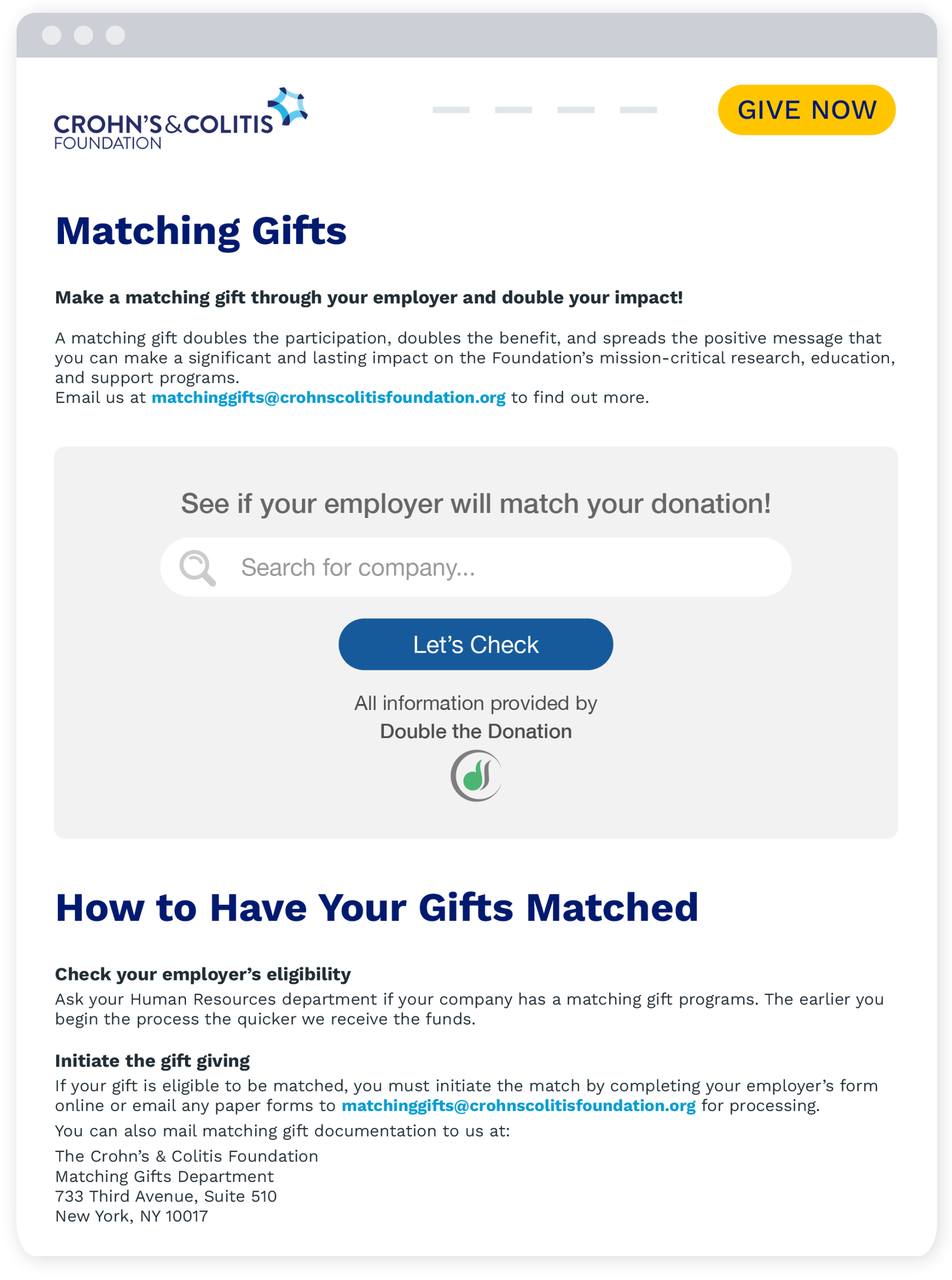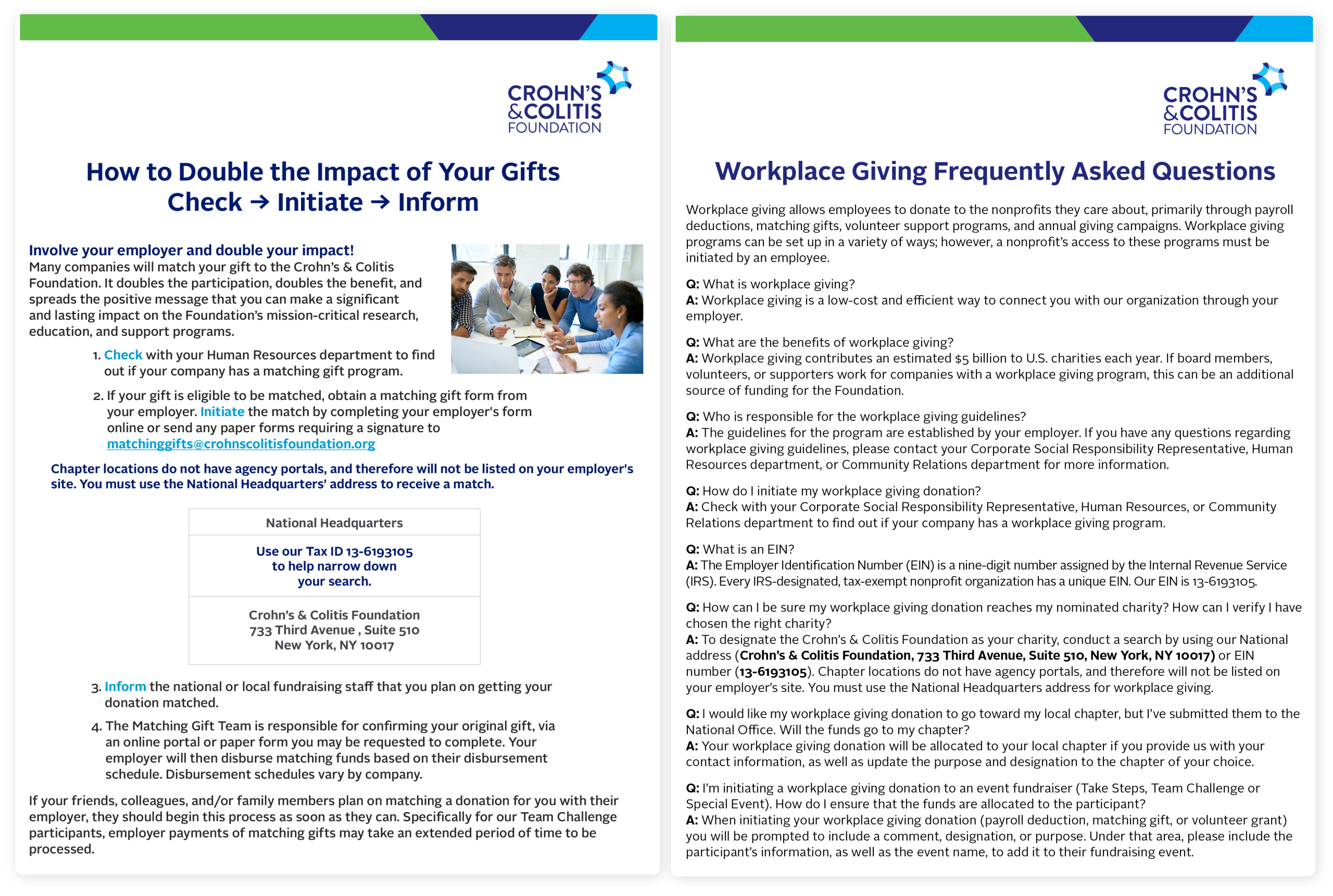Insights From Crohn’s & Colitis Foundation’s Matching Gift Journey
Matching gifts are one of the most underutilized yet powerful tools in nonprofit fundraising. When implemented effectively, they can significantly amplify donor impact and increase revenue with minimal effort. One organization that has seen tremendous success in this area is the Crohn’s & Colitis Foundation’s matching gift journey.
Over the past decade, they have entirely transformed their matching gift program from a decentralized, inconsistent process into a streamlined, high-performing operation, yielding impressive results year over year. Plus, they use Double the Donation to completely streamline and automate their efforts.
In this blog post, we’ll explore key insights from the Foundation’s journey, including how they assessed their starting point, made a plan for improvement, invested in the right tools, and trained their staff to fully support matching gifts.
Whether your organization is just getting started or you’re looking to level up your existing program, Crohn’s & Colitis Foundation’s story offers practical, actionable lessons for boosting matching gift success.
Key Takeaways:
- Assess Your Current Situation.
- Make a Plan for Improvement.
- Invest in the Right Technology to Streamline Operations.
- Train Your Staff on All Things Matching Gifts.
- Provide Internal and External-Facing Matching Gift Resources.
- Understand the Matching Gift Vendor Process.
Looking for the complete insights from this Virtual Summit presentation? Get the session replay below. Otherwise, let’s get started!
Key Takeaway: Assess Your Current Situation.
Before you can improve your matching gift strategy, it’s essential to understand where the challenges lie. At the beginning of its journey, Crohn’s & Colitis Foundation faced common obstacles—unconfirmed matches, shifting corporate guidelines, complex submission processes, and donor confusion, to name a few.
By identifying these pain points, however, they were able to take targeted steps toward improvement. This included clarifying the matching gift process, closing communication gaps, and simplifying donor guidance. Meanwhile, investing in donor education and internal training helped them better support their supporters and strengthen relationships—not just with individuals, but with the companies offering the matches.
As Kyra from Double the Donation adds, “The first step in transforming a matching gift program is not outreach, it’s a forensic data assessment. You must identify the hidden inefficiencies: where is the donor confusion, which corporate forms are consistently complex, and why are matches left unconfirmed? By isolating these friction points, the Foundation was able to create a targeted, data-driven plan rather than applying generic solutions.”
Key Takeaway: Make a Plan for Improvement.
Once you’ve identified your challenges, the next step is to create a clear, strategic plan to address them. Crohn’s & Colitis Foundation recognized that managing matching gifts at the local chapter level created inconsistencies and inefficiencies. In response, they centralized all matching gift accounts to their national office—a move that helped streamline processes, improve communication, and increase overall effectiveness.
This centralization, combined with steady improvements over time—including launching an internal matching gift site, implementing a confirmation request form, and rolling out quarterly staff trainings—enabled the organization to build a more cohesive and scalable program. As a result, they saw a 26% increase in matching gift revenue just one year after centralizing, with continued year-over-year growth driven by thoughtful planning and ongoing investment in tools and training.
Key Takeaway: Invest in the Right Technology to Streamline Operations.
Implementing the right technology can be a game-changer for your matching gift program. In 2019, Crohn’s & Colitis Foundation partnered with Double the Donation, and the impact was immediate—more than a 21% increase in matching gift revenue.
The platform made it easier to engage donors, guide them through the matching process, and ensure they had the right tools and links to submit their matches correctly. And this investment paid off in the long term. By 2021, the foundation surpassed $500,000 in matching gift revenue. By 2023, they exceeded $600,000. Even more impressively, 60% of their donors are now engaged in matching gifts, regardless of how they interact with the organization.
These results underscore the value of consistency and the importance of leveraging technology to support and scale operations. With the right tools in place, Crohn’s & Colitis Foundation has not only grown its matching gift revenue but also enhanced donor engagement across campaigns and programs.
Key Takeaway: Train Your Staff on All Things Matching Gifts.
Staff education, or internal matching gift marketing, is essential to the success of any matching gift program. At Crohn’s & Colitis Foundation, comprehensive training ensures everyone, regardless of position or experience level, understands how matching gifts work and how to support donors effectively.
Their all-staff training covers everything from the basic definition of a matching gift to the step-by-step donor journey. Special emphasis is placed on the most commonly missed step: the donor initiating the matching gift request with their employer. Live demos and real-life scenarios help staff confidently guide donors and troubleshoot common questions.
The training also clearly outlines responsibilities. While at CCF, the National Operations team manages the logistics and confirmations, chapter staff are equipped to handle donor communication and provide the necessary resources to ensure the process is completed. This approach empowers all team members to become advocates for matching gifts, ensuring a smooth experience for donors and maximizing match potential across the organization.
As Kyra from Double the Donation explains, “Internal education is the unsung hero of matching gift success. The highest barrier to completion is the donor’s confusion about the submission process. Comprehensive, real-life staff training ensures that every team member can confidently guide the donor through the steps—especially the crucial part of initiating the request with their employer—turning every staffer into a highly effective frontline matching gift advocate.“
Key Takeaway: Provide Internal and External-Facing Matching Gift Resources.
A successful matching gift program depends on clear, accessible resources for both donors and staff. The Crohn’s & Colitis Foundation has built a well-structured system that makes it easy to initiate and manage matching gifts from every angle.
Externally, they use tools like the Double the Donation plugin on their website, allowing donors to search for their employer, follow tailored instructions, and initiate a match in minutes.
They also created a concise, one-page Donor Responsibility Form and a QR-enabled Matching Gift Card—ideal for events or digital sharing—to streamline donor engagement and increase match completions.
Internally, however, the foundation developed a dedicated matching gift intranet site for staff. This hub includes everything from a matching gift update form (to notify the national team of donor activity) to submission workflows and grant application guidelines. These resources reduce email volume, ensure consistency, and keep everyone aligned.
By investing in both public-facing tools and internal systems, the Crohn’s & Colitis Foundation ensures a seamless process for donors and staff alike, boosting match completion rates and strengthening donor relationships.
Key Takeaway: Understand the Matching Gift Vendor Process.
To run an effective matching gift program, it’s essential that your staff understands how third-party vendors operate. The Crohn’s & Colitis Foundation takes time during staff training to review key vendors like Benevity, CyberGrants, YourCause, and Frontstream. After all, each of these platforms commonly processes matching gifts and payroll deductions.
For example, it’s important to note that each vendor has its own timeline and procedures. While Benevity matches typically arrive monthly, CyberGrants and YourCause each take a few weeks to process. And delays are often due to the vendors’ internal review cycles. This knowledge helps manage donor expectations and reduces confusion about gift status.
By demystifying the vendor side of matching gifts, the foundation improves internal coordination, enhances donor support, and ensures smoother, faster processing of matching gift revenue.
Wrapping Up & Additional Matching Gift Resources
The Crohn’s & Colitis Foundation’s matching gift journey is a powerful example of what’s possible when an organization commits to strategic improvements and consistent execution. By centralizing operations, investing in technology like Double the Donation, training staff regularly, and creating both internal and external resources, they built a strong infrastructure that continues to drive results. Meanwhile, their success shows that even incremental changes can yield significant gains over time.
For nonprofits looking to strengthen their matching gift programs, the Foundation’s experience underscores a clear message. Start where you are, identify your gaps, and make a plan. With the right approach, tools, and engagement, matching gifts can become a core component of your fundraising success, too. Interested in viewing the full presentation? Access the replay here!
Ready to learn more about matching gifts for organizations like yours? Check out these additional recommended resources:
- Matching Gifts in Practice: Tips, Strategies From Your Peers. Discover real-world advice from nonprofit professionals who have strengthened their matching gift programs with ease. Learn practical tips, proven strategies, and lessons learned from peers in the fundraising field.
- Key Workplace Donor Trends for Nonprofits to Know. Explore the latest research on workplace giving behavior. This includes what motivates employees to donate, how they prefer to give, and what nonprofits can do to better engage this important donor segment.
- Understanding Companies’ Expectations for Nonprofits. Gain insight into what corporate partners look for when supporting nonprofits, especially through matching gift and workplace giving programs. Learn how to build stronger, more collaborative relationships with companies here!











